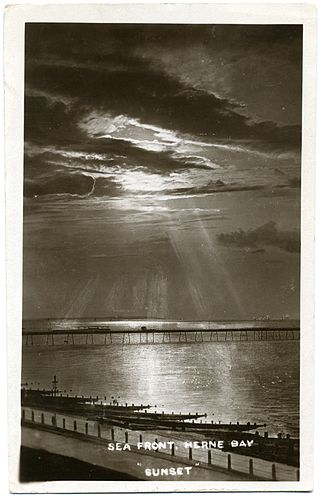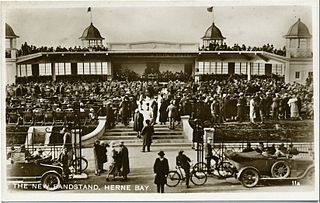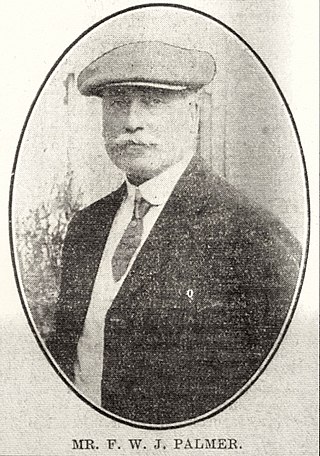
Herne Bay is a seaside town on the north coast of Kent in South East England. It is 6 miles (10 km) north of Canterbury and 4 miles (6 km) east of Whitstable. It neighbours the ancient villages of Herne and Reculver and is part of the City of Canterbury local government district, although it remains a separate town with countryside between it and Canterbury. Herne Bay's seafront is home to the world's first freestanding purpose-built Clock Tower, built in 1837. From the late Victorian period until 1978, the town had the second-longest pier in the United Kingdom.

Limelight is a non-electric type of stage lighting once used in theatres and music halls, and was the first solid-state lighting device. An intense illumination is created when a flame fed by oxygen and hydrogen is directed at a cylinder of quicklime, which can be heated to 2,572 °C (4,662 °F) before melting. The light is produced by a combination of incandescence and candoluminescence. Although it has long since been replaced by electric lighting, the term has nonetheless survived, as someone in the public eye is still said to be "in the limelight". The actual lamps are called "limes", a term which has been transferred to electrical equivalents.

Canterbury, also known as the City of Canterbury, is a local government district with city status in Kent, England. It is named after its largest settlement, Canterbury, where the council is based. The district also includes the towns of Fordwich, Herne Bay and Whitstable, along with numerous villages and surrounding rural areas. Parts of the district lie within the designated Area of Outstanding Natural Beauty of the Kent Downs.

Reculver is a village and coastal resort about 3 miles (5 km) east of Herne Bay on the north coast of Kent in south-east England. It is in the ward of the same name, in the City of Canterbury district of Kent.

Canterbury is a constituency in Kent represented in the House of Commons of the UK Parliament since 2017 by Rosie Duffield of the Labour Party.

Herne is a village in civil parish of Herne and Broomfield, in the Canterbury district, in the county of Kent, England. It is divided by the Thanet Way from the seaside resort of Herne Bay. Between Herne and Broomfield is the former hamlet of Hunters Forstal. Herne Common lies to the south on the A291 road.

Broadwater is a neighbourhood of Worthing, in the borough of Worthing in West Sussex, England. Situated between the South Downs and the English Channel, Broadwater was once a parish in its own right and included Worthing when the latter was a small fishing hamlet. Before its incorporation into the Borough of Worthing in 1902 Broadwater also included the manor of Offington to the north. It borders Tarring to the west, Sompting to the east, and East Worthing to the south-east.

The Seaside Museum Herne Bay is a local museum in Herne Bay, Kent, England. It was established in 1932, and is notable for being a seaside tourist attraction featuring local archaeological and social history, for featuring the history of the town as a tourist resort, for its local art exhibitions and for its World War II bouncing bomb. The management of the Museum was awarded by Canterbury City Council to the Herne Bay Museum Trust, who reopened it in July 2015, as The Seaside Museum Herne Bay.

Herne Bay Pier was the third pier to be built at Herne Bay, Kent for passenger steamers. It was notable for its length of 3,787 feet (1,154 m) and for appearing in the opening sequence of Ken Russell's first feature film French Dressing. It was destroyed in a storm in 1978 and dismantled in 1980, leaving a stub with sports centre at the landward end, and part of the landing stage isolated at sea. It was preceded by two piers: a wooden deep-sea pier designed by Thomas Rhodes, assistant of Thomas Telford, and a second shorter iron version by Wilkinson & Smith.

Hampton-on-Sea is a drowned and abandoned village in what is now the Hampton area of Herne Bay, Kent. It grew from a tiny fishing hamlet in 1864 at the hands of an oyster fishery company, was developed from 1879 by land agents, abandoned in 1916 and finally drowned due to coastal erosion by 1921. All that now remains is the stub of the original pier, the Hampton Inn, and the rocky arc of Hampton-on-Sea's ruined coastal defence visible at low tide. The site is notable for sharing its history with the eccentric Edmund Reid. Reid was previously the Metropolitan Police head of CID who handled the Jack the Ripper case. In retirement he chose to champion the plight of the beleaguered residents of the settlement.

Frederick Christian Palmer, known professionally as Fred C. Palmer, was the main public photographer of Herne Bay, Kent in the early years of the 20th century, working from Tower Studio. He photographed all the civic events in Herne Bay before 1914, and made portraits of the eccentric Edmund Reid, the erstwhile head of Metropolitan Police Service CID who had investigated the Whitechapel murders and then retired to Hampton-on-Sea, Herne Bay. In 1913 Marcel Duchamp used Palmer's 1910 photograph of the illuminated Grand Pier Pavilion as found object art in his Note 78, part of his Green Box artwork. In the 1920s and early 30s, Palmer took over William Hooper's Cromwell Street studio in Swindon, again producing local postcards, photographing prominent people and doing freelance work for local newspapers and the Council.
Monkhouse Davison (1713–1793) was the senior partner in one of the leading grocers in 18th century London, Davison Newman and Co., that imported a wide range of produce including tea, coffee, sugar and spices. The company is best known today for the disposal of chests of its tea in the Boston Tea Party at the start of the American Revolution. Products branded with the company name are still being sold, over 360 years after its foundation.

Eddington was a village in Kent, South East England to the south-east of Herne Bay, to the west of Beltinge and to the north of Herne. It is now a suburb of Herne Bay, in Greenhill and Eddington Ward, one of the five wards of Herne Bay. Its main landmark for over 100 years until 2010 was Herne Bay Court, a former school which once possessed one of the largest and best-equipped school engineering workshops in England; it later became a Christian conference centre.
Smith of Derby Group is a clockmaker based in Derby, England founded in 1856. Smith of Derby has been operated continuously under five generations of the Smith family.
The Kent League was a football league which existed from 1894 until 1959, based in the English county of Kent. Another, unrelated, Kent League was formed in 1966, and is now known as the Southern Counties East Football League.

The Central Bandstand, known as the Bandstand, in Herne Bay, Kent, England, was designed by H. Kempton Dyson in 1924, extended with an art deco frontage in 1932, and refurbished between 1998 and 1999. It is one of the coastal landmarks of the town. When first built, it was a popular venue for visiting military band concerts and for tea dances. Edwina Mountbatten spoke there on behalf of the Red Cross in 1939. In the 1920s and 1930s a red carpet would be laid across the road and up to the stage for the conductor of the brass band to walk from the Connaught Hotel which was directly opposite the Bandstand.

The King's Hall is a theatre, concert hall and dance hall at Herne Bay, Kent, England. It was built as The Pavilion in 1903–1904, developed as the King Edward VII Memorial Hall in 1913 in memory of the late king, and was being called The King's Hall by 1912 while still at planning stage. Both building phases were designed by the local Council surveyor F.W.J. Palmer, CE. The year 2013 was the centenary of the completion of the second and final phase of this building and its grand opening by Princess Beatrice on 10 July 1913.

Frederick William J. Palmer, CE, (1864–1947), known professionally as F. W. J. Palmer, was an English civil engineer, structural engineer and surveyor. From 1891 he was Surveyor to Herne Bay Urban District Council. As Town Surveyor between at least 1891 and 1915 he was responsible for arranging the digging up of a great deal of Herne Bay. He organised the reconstruction of all the main roads, saw to the rebuilding of the council offices and Hampton Pier and led the construction of a new sea wall. He led the Sewerage of the East Cliff and nine miles of private roads at the east end of Herne Bay. He designed both phases of the King's Hall, Herne Bay. His works helped to provide employment and to make the town what it is today. Archaeological artefacts turned up by his constant digging contributed to the collection now in Herne Bay Museum.

Ann Thwaytes, known to contemporaries as Mrs Thwaytes, was the wealthy and eccentric English widow of grocer William Thwaytes, owner of Davison, Newman & Co. She became the benefactress to many causes and funded the construction of the Clock Tower, Herne Bay.
Ching Lau Lauro and Professor Ching were the stage names of a juggler and magician who performed outdoors and in theatres in London and the provinces. His real name is unknown; he was possibly Cornish and he was popularly known as Ching. He was the first magician in Europe to perform the aerial suspension illusion, and possibly the first to use limelight, and one of the earliest Western magicians to perform in Chinese costume. In 1834 he played at The Theatre, Leeds.

























